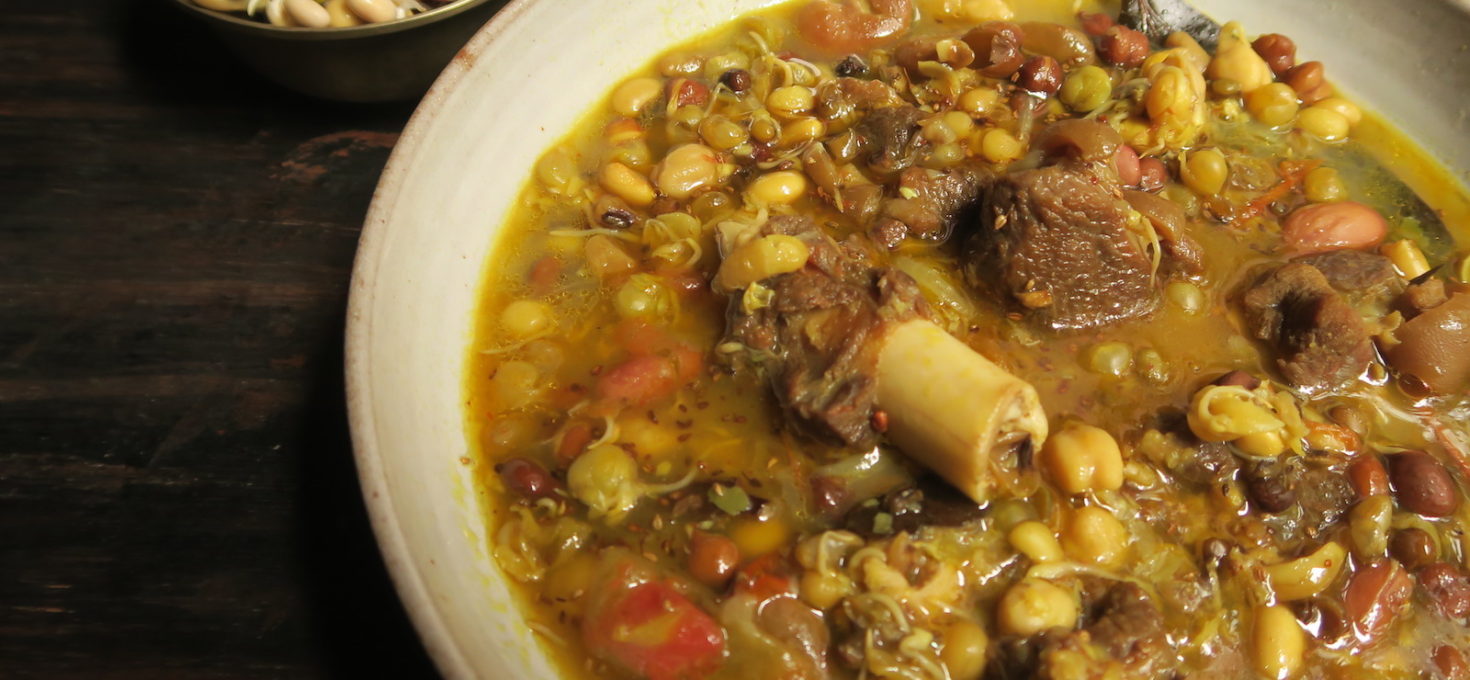This article was originally published in The Kathmandu Post, 31 July 2020
Prashanta Khanal
After a couple of months of arduous work on paddy fields, Kathmandu’s farmers nourish their body by consuming mixed sprouted legumes soup called ‘Kwati’ on the full moon festival ‘Kwati Punhi’ or ‘Gunhu Punhi’. Newas celebrate the festival towards the end of monsoon. Also known as Janai Purnima, Hindus celebrate the day by tying a sacred thread around their body and wrist.
Kwati is prepared from a mixture of nine types of legumes; some say the nine legumes signify the ninth month of Nepal Sambat calendar in which the festival is celebrated. The legumes include fava bean, soybean, mung bean, gram, field pea, garden pea, black-eyed pea, etc. The legumes are soaked overnight, germinated, and cooked into soup. Locals believe that the soup makes the body immune to seasonal ailments and improves the digestive system.
During the germination, the legumes go through bio-chemical changes and become more nutritive with increase in amino acids, polyphenols, Vitamin C, minerals, and decline in starch and anti-nutrients. Research suggests that the increase in helpful bacteria Lactobacillus bifidus during the germination, which inhibits the growth of harmful microbes, is good for your digestive tract. This, along with the bio-chemical changes, is probably what gives kwati soup its distinctive, delicious flavour, something that you won’t get from just-soaked beans.
Kwati in Newa language translates to hot soup—‘kwa’ means ‘hot’ and ‘ti’ refers to ‘soup’. The word ‘kwa’ is also used in other Newa dishes such as ka-kwa, pancha-kwa, paun-kwa. ‘Kwa’ more likely refers to ‘various ingredients’.
In Newa households, sometimes bone-in buffalo meat, chhuchunmari (wheat flour dumplings or roti), or even momo are added in kwati. Some of Kathmandu’s non-Newas adopt the kwati recipe and cook it with goat meat (colloquially known as mutton in South Asia).
Kwati is in itself delicious but bone-in goat meat adds to the flavour. Goat meat has a good dense gamey flavour and aroma—good for making soup. The bone marrow, fats, and meat add rich flavour, and gelatinous skin thickens the soup and gives texture.
I am not sure if the recipe is common but I got this recipe from a Khas-family living in Kathmandu. The soup is delicious and I make it at least once a year during Kwati Punhi. Here it is so you can try to make it too:
Ingredients:
(Serves 3–4 people)
200 gm kwati beans
250–300 gm bone-in goat meat or goat legs, cut in bite-size pieces
1 onion, medium sized
3–4 cloves
3–4 green cardamoms
2–3 bay leaves (tejpatta)
1 cinnamon stick
1 tablespoon garlic and ginger paste
1 teaspoon turmeric powder
1 teaspoon cumin and coriander powder
1 teaspoon red-chili powder
1 teaspoon garam masala, optional
2–3 tomatoes, medium-sized
2 tablespoons vegetable oil
Salt
For marinating meat:
1 teaspoon ginger and garlic paste
1 teaspoon cumin and coriander powder
1/3 teaspoon black pepper powder
½ teaspoon turmeric powder
1 tablespoon vegetable oil
1 teaspoon salt
For spice tempering:
1 tablespoon ghee
½ teaspoon ajwain seeds (jwano)
Directions:
1. The prep for kwati soup requires two days. To sprout kwati beans, you have to first soak the beans overnight. Then drain the beans, put them on a clean, cotton cloth, and keep it in a dry, dark place. Let the legumes sprout for about 24 hours or more. Sprinkle water a couple of times to keep it moist.
2. At least before 4–5 hours (overnight is better) before cooking the kwati, marinate the meat with garlic and ginger paste, cumin and coriander powder, black pepper powder, turmeric powder, salt, and vegetable oil.
3. For the kwati soup, heat about two tablespoons of vegetable oil in a pressure cooker over medium heat. Add cloves, cinnamon, green cardamoms, and bay leaves. Then add finely sliced onions, ginger and garlic paste, and turmeric powder. Fry until the onion turns light brown.
4. Add meat and cook for around 6–8 minutes, stirring occasionally until the meat browns lightly. Add sprouted kwati beans, chopped tomatoes, cumin and coriander powder, garam masala (optional), red chilli powder and salt. Mix well and continue to cook for another 6–8 minutes. Pour in 2–3 cups of hot water, cover the pot and pressure cook for 15 minutes in low heat (or for around 3–4 whistles). Turn off the heat and let the pressure cooker cool down.
5. Take the lid off of the pressure cooker, add 3–4 cups of hot water (or depending upon the quantity of soup you want to make), and cook it over low-medium heat for about 10–12 minutes. Take the pressure cooker off the heat.
6. In a small pan, heat a tablespoon of ghee and fry the jwano. Turn off the heat and pour it in the soup. The kwati with goat meat is ready. You may garnish with some fresh coriander leaves. Then, relish the soup on its own or enjoy it with rice.
Prashanta Khanal
Khanal is a food writer, and is currently working on a book on Nepali recipes, food culture, and history. He writes on Nepali food culture and recipes on his food blog ‘Gundruk’.
